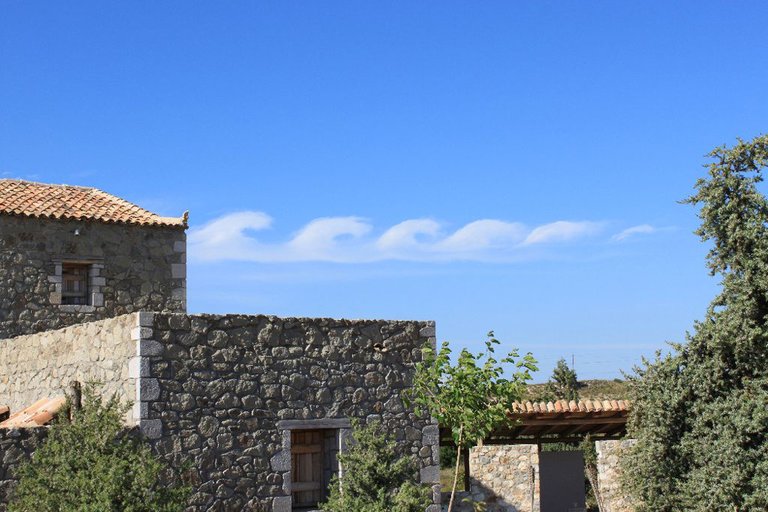
German:
Auf der Suche nach einem Griechenland-Bild für eine Illustration bin ich bei meinen Urlaubsbildern auf diese Aufnahme gestoßen. Das Bild wurde während unseres Urlaubes im Mai 2010 auf der Insel Kos in der Ägäis aufgenommen. Als ehemaliger Beamter des Deutschen Wetterdienstes achte ich immer auf den Himmel. Allerdings hatte ich ein solches Wolkenbild noch nie live gesehen und musste es sofort mit der Kamera festhalten.
Bei der Wolke handelt es sich um eine Rotorwolke. Diese Wolken treten bei höheren Luftgeschwindigkeiten im Lee von Bergen oder Gebirgen auf. Durch das angeströmte Hindernis kommt es zu einer Wellenbildung, die dann zu dieser ortsfesten Wolkenbildung führt. Während die sogenannten Lentikulariswolken (linsenförmige hohe Wolken) sehr häufig vorkommen, sind die tieferliegenden Cumuluswolken im Bereich des Rotors eher selten.
Der Rotor (auch Wirbelwalze genannt) bildet sich zwischen der schwingenden Luft-Schicht und der Luftbewegung in Bodennähe. Durch seine starken Turbulenzen ist er für die Luftfahrt äußerst gefährlich. In diesem Fall wurde der starke Nordwind (auch Meltemi genannt) von der Insel Kalymnos in Schwingung versetzt.
Die Wolke hielt sich etwa 1 Stunde ehe sie wieder verschwand.
Ich habe bis heute eine solche Wolke nie wieder gesehen, könnte mir aber vorstellen, dass man diese Art Wolken im Alpenvorland bei Fön auch beobachten kann. Also schaut ab und zu mal in den Himmel. :)
Hoffentlich hat euch das Bild und auch meine Erklärung für das Phänomen gefallen.
Ich wünsche allen ein schönes Wochenende.
English:
Looking for a Greece image for an illustration, I found this shot on my vacation pictures. The picture was taken during our vacation in May 2010 on the island of Kos in the Aegean Sea. As a former official of the German Weather Service, I always pay attention to the sky. However, I had never seen such a cloud image live and had to capture it immediately with the camera.
The cloud is a rotor cloud. These clouds appear at higher air velocities in the lee of mountains. Due to the obstructed obstacle, it comes to a wave formation, which then leads to this stationary cloud formation. While the so-called lenticular high clouds are very common, the deeper cumulus clouds in the area of the rotor are rather rare. The rotor (also called turbulence roller) forms between the oscillating air layer and the air movement near the ground. Due to its strong turbulence, it is extremely dangerous for aviation. In this case, the strong north wind (also called Meltemi) was set in motion by the island of Kalymnos.
The cloud lasted for about an hour before disappearing again.
I've never seen such a cloud until today, but I could imagine that you can also observe this kind of clouds in the lee of other hills and mountains around the world. It's a bit of magic. So, check the sky now and then. :)
I hope you liked the picture and my explanation for the phenomenon.
(I had used Google Translate for some parts, hope it translated well.)
I wish everyone a nice weekend.
Coole Wolke ! Hab ich auch noch nie gesehen und ich dachte erst an eine Fotomontage. Danke für das Stückchen Allgemeinbildung !
Ja, die Natur überrascht uns immer wieder. Die Wolke in dieser Art ist wirklich sehr selten. Schon öfter sieht man eine "Wolkenwurst" in dem Bereich des Rotors.
Very interesting post... this makes sense... how the mountains are affecting the formation. Mountains can cause interesting phenomena for sure! Like rain or storms on one side and not the other!
Yes, that's why weather forecasts for small regions are so difficult.
Makes perfect sense as well... just like a forecast of 40% means 40% of the area has a chance of rain... :)
And yet, orography is just one part of the complex and chaotic system.
Sehr seltsam, habe dir ein upvote auf deinen Kommentar bei mir gegeben und dann war unsere ganze "Konversation" gelöscht??? Viele Grüße, ANNIC
Ist noch da. Die Konversation rutscht dann etwas noch oben, upvote eben.
Hallo @ikarus56, wunderschönes Bild und interessanter Post. Liebe Grüße Alexa
Vielen Dank.
Posted using Partiko Android
In unser Büro kommen auch oft Rotorwolken herein.
Dann muss ich aufpassen, dass sich keine ortsfesten
Wolkenbildungen ergeben.
Die Wirbelwalzen versuche ich dann möglichst schnell
abzustellen und das Problem zu lösen.
Bei Nordwind muss ich mir andere Strategien einfallen
lassen.
Vielen Dank für das Bild und Deinen Bericht.
Viele Grüße.
Ja, bei einem chaotischen System muss man auf alles gefasst sein. :)
Guten Tag,
Mein Name ist GermanBot und du hast von mir ein Upvote erhalten. Als UpvoteBot möchte ich dich und dein sehr schönen Beitrag unterstützen. Jeden Tag erscheint ein Voting Report um 19 Uhr, in dem dein Beitrag mit aufgelistet wird.
In dem Voting Report kannst du auch vieles von mir erfahren, auch werden meine Unterstützer mit erwähnt.
Schau mal bei mir vorbei, hier die Votings Reports.
Mach weiter so, denn ich schaue öfter bei dir vorbei.
Euer
GermanBot
This post has received a 3.13 % upvote from @drotto thanks to: @patternbot.